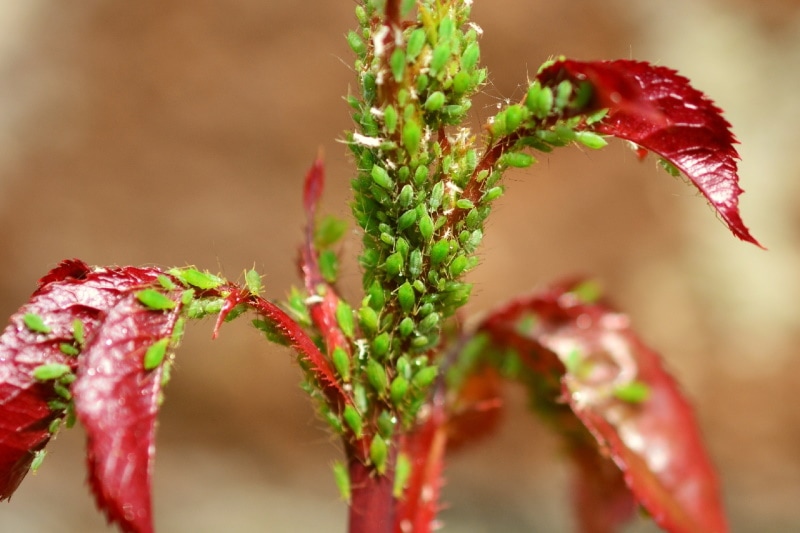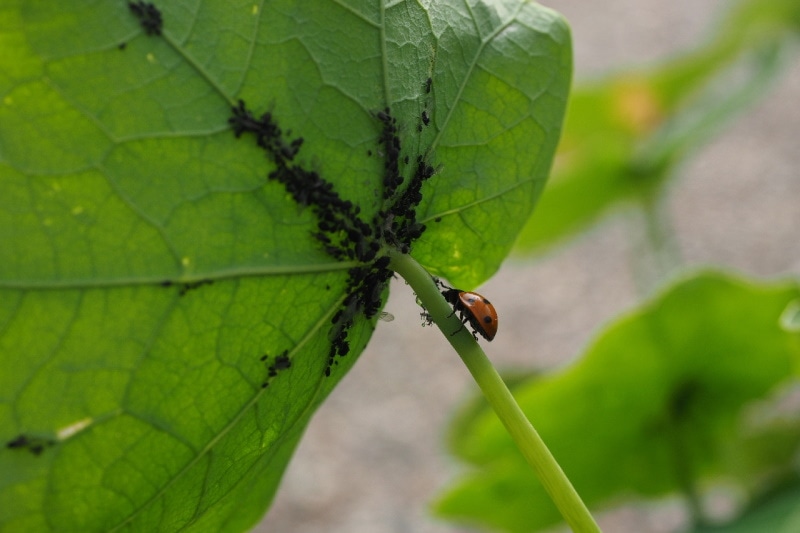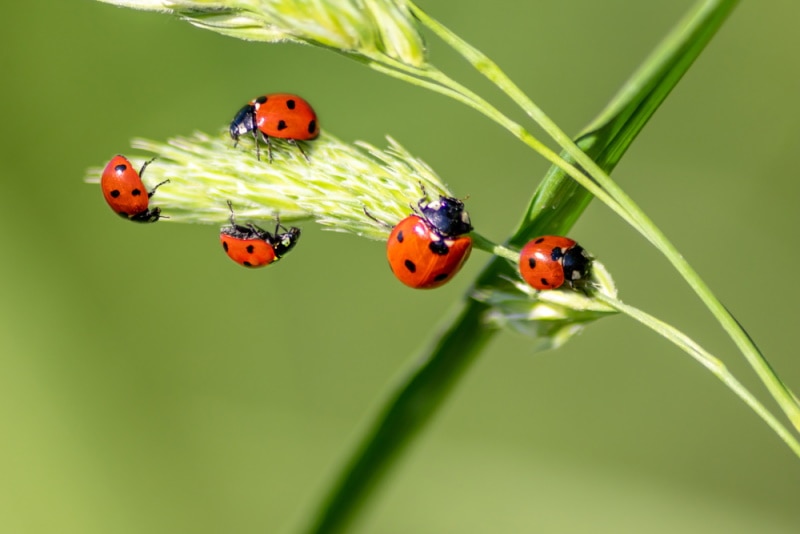Do Ladybugs Eat Aphids? Tips, Alternatives, & FAQ
-
Pete Ortiz
- Last updated:

Ladybugs are one of the most fan-favored insects on the planet. They rarely bite, don’t make annoying noises, and don’t devour the crops. More than that, these lovely beetles are classified as beneficial insects. They feed on pests, helping gardeners and farmers keep their plants alive. But do ladybugs eat aphids, though? The answer is yes, they do.
So, how do you attract them to your garden? How many aphids does the average lady beetle eat a day? What other benefits do they have? It’s time to get some answers. Check this article out!
What Is a Ladybug? Is It a Beneficial Insect?
Ladybugs symbolize prosperity and good luck and are loved and cherished across the globe. Easily recognizable by their dome-shaped bodies and colorful wings, they live for 2–3 years in the wilderness and reach 0.3–0.4 inches in size. More importantly, they don’t spread any diseases and don’t damage crops. Ladybugs belong to the Coccinellidae family, which includes more than 6,000 different species.
Most of these insects are classified as beneficial. They feed on agricultural pests, including scale insects and, of course, aphids. That said, a very small number of beetle species are not welcome in a garden or farm because they ravish the plants, not the bugs. Mainly, we’re talking about the squash beetles and the Mexican bean beetles. But for the most part, ladybugs are of great help.
Aphids: How Dangerous Are They?

These pests are not harmful to humans. They do, however, pose a great threat to our crops. When left untreated, they can ravish an entire garden. In agriculture, aphids are known as some of the most dangerous destructive bugs. They are naturally attracted to plants cultivated in gardens and farms across the States. Aphids pierce right through the stems and feed on the nutrient-rich sap.
An aphid infestation makes the plants turn yellow (or brown) and stunts growth, which leads to low yields. Depending on the species, the insect may inject a harmful toxin into the plants and carry diseases/viruses, which will have an even greater negative effect on the garden. So, yes, these pests are, indeed, a disaster. In the US alone, there are 1,350 aphid varieties.
So, Do Ladybugs Feed on Aphids?
For gardeners, ladybugs are not just a sight for sore eyes but rather an effective “tool” against pests. Now, most lady beetles we see in North America have red wings with black dots. However, these aren’t the only ladybugs that eat pests. Some are yellow, orange, red, and even black; the textures vary as well. But the one thing that they have in common is a great appetite for aphids.
A single ladybug eats around 50 aphids a day, which sums up to more than 5,000 devoured pests in its lifetime! And that’s because they’re used to snacking on aphids “from the cradle”. That’s right: ladybird beetles find pest colonies in forests, meadows, and gardens, laying hundreds, if not thousands, of eggs there. So, when the eggs hatch, the larvae have their food waiting for them!
What Else Do Ladybugs Like to Eat?

Aphids are the main treat for lady beetles, but they also feed on whiteflies, spider mites, thrips, scale, moth eggs, leafhoppers, and mealybugs. Every single one of these bugs is categorized as a pest because they damage garden plants. Just like aphids, they like to drink the sap, leaving the crops to die a slow death. Therefore, if your garden is overcrowded with various pests, using lady beetles against them will be a great idea.
How Do You Attract Ladybugs to a Garden?
There’s nothing hard about this part. Ladybugs are mostly attracted to flower beds. If you plant some roses, marigolds, or yarrows, you’ll start to see more lady beetles hanging around your garden. The butterfly weed, angelica, and goldenrod can also serve as magnets for these cute bugs. And what if there aren’t any flowers in the garden?
Can you attract ladybird beetles with veggies? The answer is yes, but for the best results, you need to have lots of tomato and cucumber crops on the property. They are the best lure; eggplants and peppers work as well. Overall, when in large numbers, these flowers and vegetables do a decent job of attracting ladybugs.
How Many Ladybugs Are Enough?
We’ve learned that ladybugs are a blessing to have around the garden. But how many do you need to successfully control an infestation? On average, 100 ladybugs should be enough to cover 1,000 square feet. As long as there’s a water and food source nearby, they will start laying eggs in 2–4 weeks.
For a small-sized garden, around 1,500–2,000 lady beetles will do. Larger gardens, in turn, need 10,000–20,000 to keep aphids at bay. The exact number depends on the size of the garden, climate, ladybug species, and other factors. Agriculture isn’t an exact science, of course, but these estimates should help you get started.
Where Do You Find This Many Ladybugs?

Not having much luck attracting lady beetles to your garden? Maybe that’s because you live in a climate zone that ladybugs don’t like very much. Or, maybe their population is low this year—that happens as well. But don’t worry, you can always buy them. A can or bag of 1,000–1,500 ladybugs costs $5–15. We’re talking about live, adult bugs that are “ready to rumble”.
As mentioned, 100 ladybugs cover up to 1,000 square feet. So, start there. Grab a dozen or so ladybugs and put them right next to a plant that’s taken over by aphids. Do this every 20–30 feet. If you don’t yet see any aphids/other pests in the garden, keep the bag of ladybird bugs in the refrigerator at 35–45°F, but for no longer than 1–3 months.
Using Ladybugs Against Aphids: A Quick Guide
If you’ve been keeping ladybugs in a fridge for more than a week, they will, most likely, be dehydrated. Another fact to keep in mind is that these insects aren’t big fans of summer heat. That’s why it’s recommended to release them early in the morning or late in the evening when the temperatures are relatively low and there’s enough dew for them to drink. Or you can spray some water on the plants.
Also, make sure the aphid numbers in your garden or backyard are large. Otherwise, the lady beetles will fly away to find new sources of food. The ones that are sold at garden centers and nurseries prefer aphids over other pests, by the way. This is important: don’t use any pesticide products before releasing ladybugs into the garden. It will kill most of them and scare the rest away!
Always Have Extra Ladybugs Available

The one thing that most gardeners and farmers fail to realize is that lady beetles don’t stick around in one place for long. Even if there are plenty of aphids to feed on and you spray the plants every day, once the pest population reaches zero, ladybug beetles will migrate to another area. More than 90% of ladybugs fly away within two days after they’re released and don’t lay any eggs.
The rest join them in 4–5 days. So, if the pests return, you’ll have to use a new group of ladybugs to counter them. Otherwise, they will take over the garden. Or, if you want to try something new, use insecticides. The key takeaway is that ladybugs are not a permanent remedy against aphids or any other destructive bugs. They are highly effective, that’s true, but only for a short period.
The Best Alternatives to Lady Beetles
Ladybugs aren’t the only solution against pests. If you don’t have any around, that doesn’t mean you’ll be left one-on-one with aphids. There are quite a few beneficial insects out there that like to include aphids in their daily diet as well. And, while some of these might not be as effective, if you’re looking for “free labor” to help around the garden, here’s a quick look at the best candidates:
- Soldier beetles (adults)
- Syrphid flies (larvae)
- Green lacewings (adults)
- Aphidius colemani (larvae)
- Greenhouse aphid parasite (larvae)
- Aphidoletes aphidimyza (larvae)
Conclusion
Ladybugs are cute and fun to have around the property. Plus, they are a natural remedy against aphids and other destructive bugs that ravish plants. All you have to do is find ways to attract them to the backyard, and they’ll take care of the rest. As we learned today, an adult ladybug can devour quite a large number of aphids (up to 50 per day).
More good news: lady beetles are harmless to garden crops. And, while they might sting when provoked, their bites can’t break the skin. This is true not only for adults but also kids and pets. So, if you have an aphid problem and need to deal with that ASAP, lady beetles will get the job done!
Featured Image Credit: Keith Hider, Shutterstock
Contents



